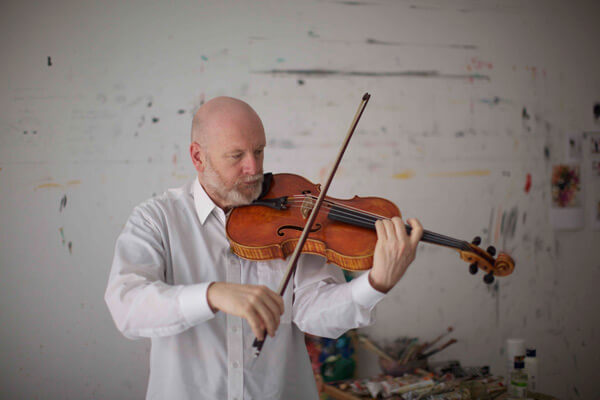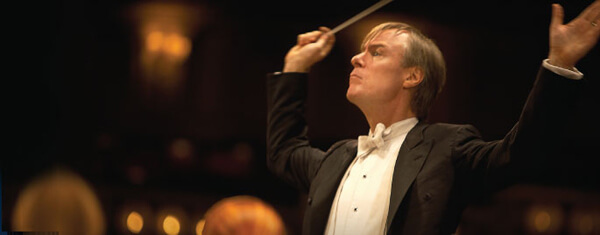

Composer-violist Brett Dean (photo credit: Pawel Kopczynski)
As with many composers, Dean finds musical inspiration in literary works. With Testament, however, he also draws inspiration from the actual physical act of writing, specifically Beethoven sitting at a desk writing his Heiligenstadt Testament. Dean’s Testament begins quietly but breathlessly as if a curtain lifts to reveal the despairing, bent-over composer furiously pouring his heart out in fits and starts with his quill and parchment. A screen projects an image of Beethoven’s written testament, connecting the musical sounds to the visual. The violas start with unrosined bows that create a scratchy, hazy tone akin to that of a pen on paper. Only occasionally and randomly do the bows gain enough traction on the strings to produce a clear tone.
Beethoven’s Heiligenstadt Testament chronicled the composer’s despair over his descent into deafness. The unrosined strings’ impaired sound invokes Beethoven’s ailment: bits and pieces of sound are heard, some clear, some faint others not at all or just imagined. Visually symbolic are the frequent passages where the audience sees members of the ensemble sawing away madly but producing little or nothing to hear. This is music of pure frustration, anger and self pity which the ensemble communicated in abundance. The music grows more reflective as members of the group slowly switch to the rosined bows. Moments of clarity become more frequent as fragments from Beethoven’s Opus 59 No. 1 “Razumovsky” Quartet emerge from the gause-y fog. Testament becomes more agitated and tormented as the full ensemble revisits the opening music but now using rosined bows. The Razumovsky quotes fade, becoming an occasional faint echo, as the music again descends into haze. The work ends in this ambivalent mode with an air of resignation.
Martyn Brabbins and the violas of the BBC Symphony Orchestra recorded this viola-only version of Testament for the BIS label in 2013 and there is also a 2008 recording of the chamber orchestra version on the ABC Classics label. This spectacular and arresting performance of the twelve-viola version clearly demonstrated it is the preferred way to hear this passionate, imaginative piece. Dean and the eleven members of the symphony’s viola section were clearly inspired by Testament, giving the appreciative audience a memorable, certainly definitive, performance.

St. Louis Symphony Orchestra Music Director David Robertson (photo credit: stlsymphony.org)
Cast in three movements, a short prelude followed by two more substantial movements, Dean’s Viola Concerto is devoid of any literary references. As stated by the composer in the program notes, the work is inspired solely by the sound, technique and the composer’s “…relationship with this curiously beautiful, somewhat enigmatic instrument of my choosing.”
“Fragment” at approximately 3 minutes in length, introduces most of the work’s thematic and sound material. This delicate prelude fades into the frantic, propulsive second movement “Pursuit.” Dean showed his spectacular technique in this flashy scherzo with soaring leaps, jagged, frenetic passages and a birdsong-filled central section providing a brief respite from the chase. Robertson and the orchestra, as the pursuer, propelled the movement along with crisp strings, biting winds and colorful pulsing percussion.
The closing movement “Veiled and Mysterious” begins in the same sound world as “Fragment” with the viola intoning a long, melismatic lament over dense, cold orchestral chords. After an impassioned, dramatic section dominated by the orchestra, the viola returns entwining its melodic line with the oboe and English horn as the work draws to another ambiguous close. For all its effort, the work frequently degenerates into note spinning that frankly pales in comparison to the more economical and evocative Testament.
Robertson clearly has an affinity for Dean’s music and led a thoughtful performance, keeping the largish, well rehearsed orchestra in balance with the soloist. Dean’s viola was simply breathtaking with its rich, milk chocolate tone.
The second half of the evening was devoted to a powerful and flawlessly executed Beethoven Symphony No. 3 “Eroica,” a work written in the shadow of his Heiligenstadt Testament. As the “Eroica” progressed it was impossible to not reflect back to Dean’s Testament. One could visualize a tortured and frustrated Beethoven writing this revolutionary music knowing he would always hear it behind a veil of deafness. A simply brilliant stroke of programming that lifted this familiar work to a new level of appreciation.
